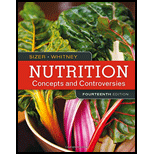
Nutrition: Concepts and Controversies
14th Edition
ISBN: 9781305886865
Author: Sizer, Frances , WHITNEY, Ellie
Publisher: Cengage Learning
expand_more
expand_more
format_list_bulleted
Question
Chapter 1, Problem 6SC
Summary Introduction
Introduction:
Nutrients are substances present in the food items, which allow the body to build energy, tissues, and further help in the regulation of the body’s
Expert Solution & Answer
Trending nowThis is a popular solution!

Chapter 1 Solutions
Nutrition: Concepts and Controversies
Knowledge Booster
Similar questions
- Which of the following statements is not true? a. Essential nutrients can be synthesized by the body. b. Vitamins are required in small quantities for bodily function. c. Some amino acids can be synthesized by the body, while others need to be obtained from diet. d. Vitamins come in two categories: fat-soluble and water-soluble.arrow_forwardSome nutritionists claim that the secret to long life is to be slightly underweight as an adult. If a persons weight is related partly to diet, partly to activity level, and partly to genetics, what underlying factors could be at work to generate statistics that support this claim?arrow_forward
Recommended textbooks for you
 Comprehensive Medical Assisting: Administrative a...NursingISBN:9781305964792Author:Wilburta Q. Lindh, Carol D. Tamparo, Barbara M. Dahl, Julie Morris, Cindy CorreaPublisher:Cengage Learning
Comprehensive Medical Assisting: Administrative a...NursingISBN:9781305964792Author:Wilburta Q. Lindh, Carol D. Tamparo, Barbara M. Dahl, Julie Morris, Cindy CorreaPublisher:Cengage Learning- Health Safety And Nutrition F/Young ChildHealth & NutritionISBN:9781305144767Author:MAROTZPublisher:Cengage



Comprehensive Medical Assisting: Administrative a...
Nursing
ISBN:9781305964792
Author:Wilburta Q. Lindh, Carol D. Tamparo, Barbara M. Dahl, Julie Morris, Cindy Correa
Publisher:Cengage Learning



Health Safety And Nutrition F/Young Child
Health & Nutrition
ISBN:9781305144767
Author:MAROTZ
Publisher:Cengage